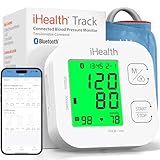A Smart Choice for Home Health Tracking
Why everyone should consider using one, even if you’re healthy
What is a blood pressure monitor?
A blood pressure monitor is a device that measures the force of your blood pushing against the walls of your arteries. It provides two numbers: systolic (the pressure during heartbeats) and diastolic (the pressure between beats). Keeping track of these numbers can help you detect hypertension early, manage chronic conditions, and make informed decisions about your health.
Why monitor your blood pressure at home?
Many people only discover high blood pressure during a routine doctor visit—often after it has been affecting their body for years. Monitoring at home helps you:
💡 Spot trends over time
📉 Detect silent hypertension
🧘 Reduce anxiety from “white coat syndrome”
🩺 Provide accurate data to your healthcare provider
Types of blood pressure monitors
🏠 **Upper Arm Monitors**: Most accurate and commonly recommended.
✋ **Wrist Monitors**: More compact but can be less accurate if not used properly.
📱 **Smart Monitors**: Sync with apps for tracking and reminders. Great for tech-savvy users.
Best Selling Blood Pressure Monitors
Last update on 2025-10-02 / Affiliate links / Images from Amazon Product Advertising API. Disclaimer: As an Amazon Partner, I may be compensated if you make a purchase - at no additional cost to you.
Tips for getting an accurate reading
✅ Sit quietly for 5 minutes before measuring
🪑 Keep your arm at heart level and rest it on a table
☕ Avoid caffeine, smoking, and exercise 30 minutes prior
🕐 Take readings at the same time daily
📊 Record your readings and note any unusual factors (stress, lack of sleep, etc.)
How often should you take your blood pressure?
If you’re healthy and just keeping tabs, once or twice a week is enough. If you’ve been diagnosed with high blood pressure or are on medication, your doctor may recommend daily readings—often twice a day (morning and evening).
Understanding your readings
📈 **Normal**: Under 120/80
⚠️ **Elevated**: 120–129 systolic and less than 80 diastolic
🔴 **High (Stage 1)**: 130–139 systolic or 80–89 diastolic
🩸 **High (Stage 2)**: 140+/90+
🚨 **Hypertensive Crisis**: 180+/120+ — seek medical attention immediately
Why it matters
High blood pressure is known as the “silent killer” for a reason—it often has no symptoms until serious damage has occurred. Tracking your numbers at home is one of the easiest and most effective ways to protect your heart, brain, and kidneys.
Final thoughts
A home blood pressure monitor is a small investment with big potential. Whether you’re managing a medical condition or just keeping an eye on your health, it puts knowledge and control back in your hands.
Last Updated on 2 April 2025 by ingminvip



